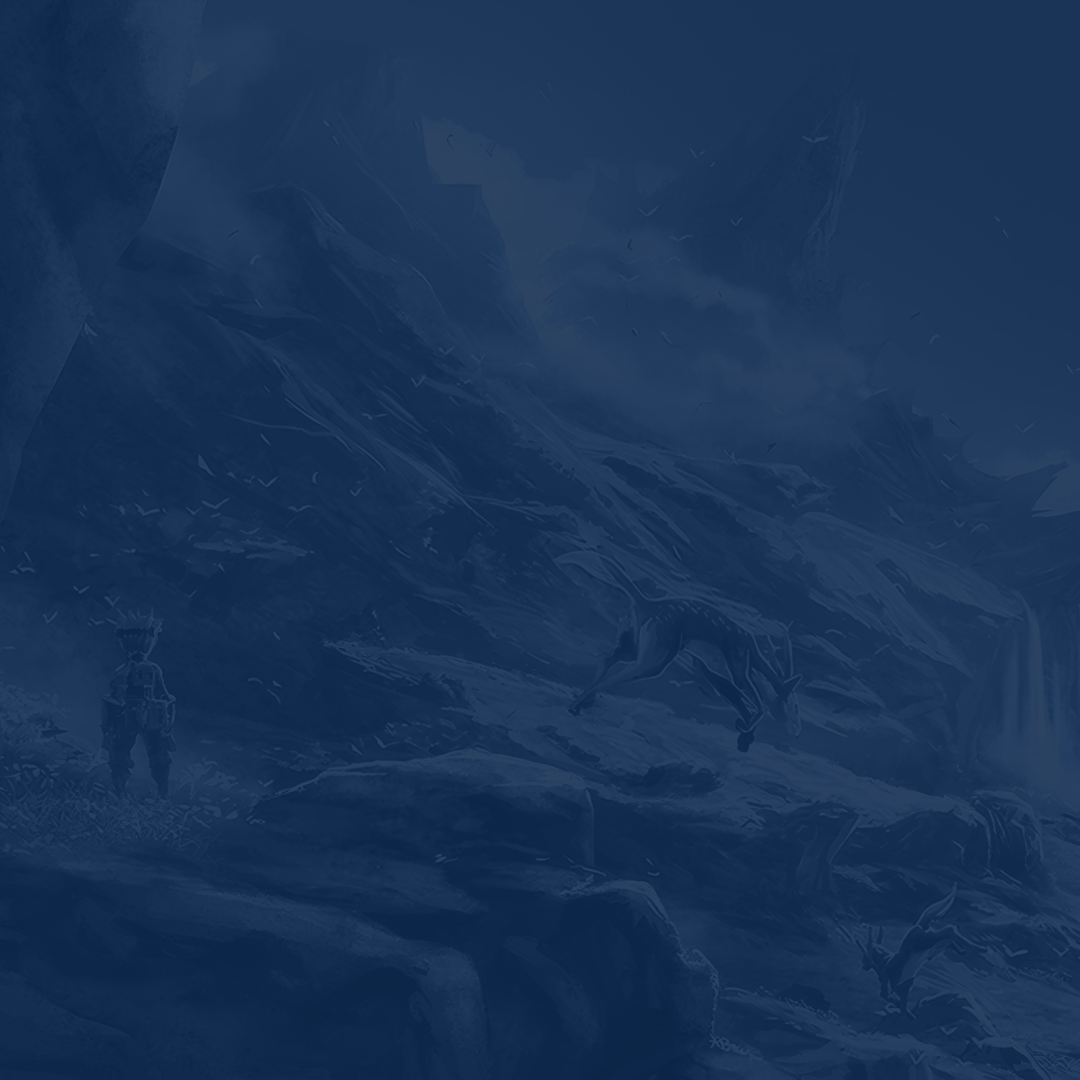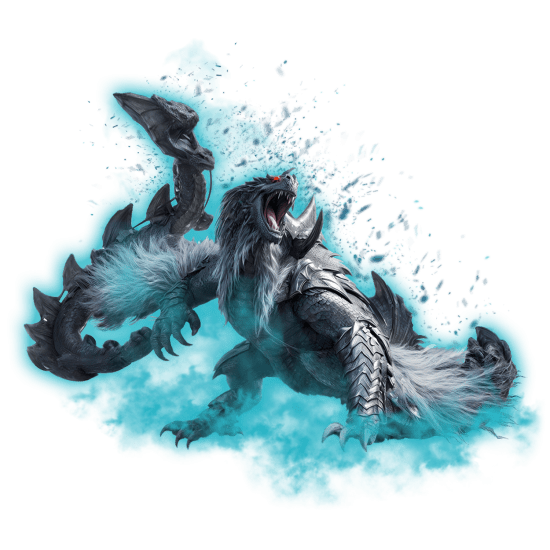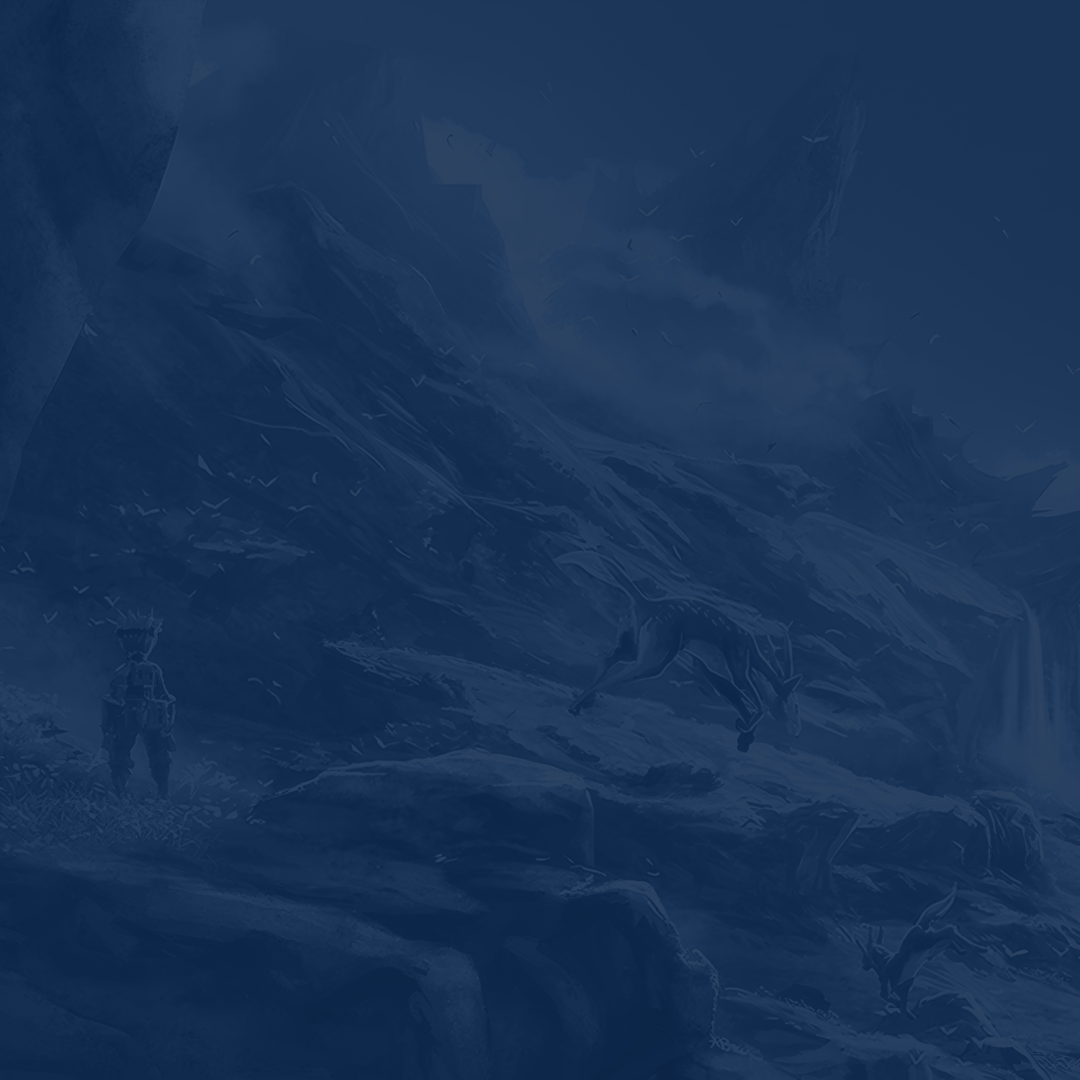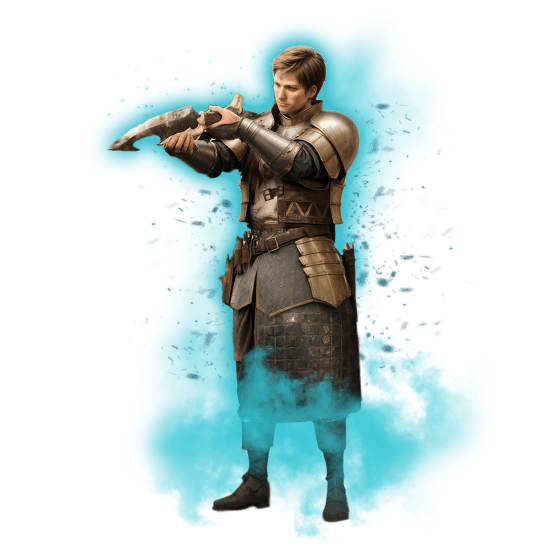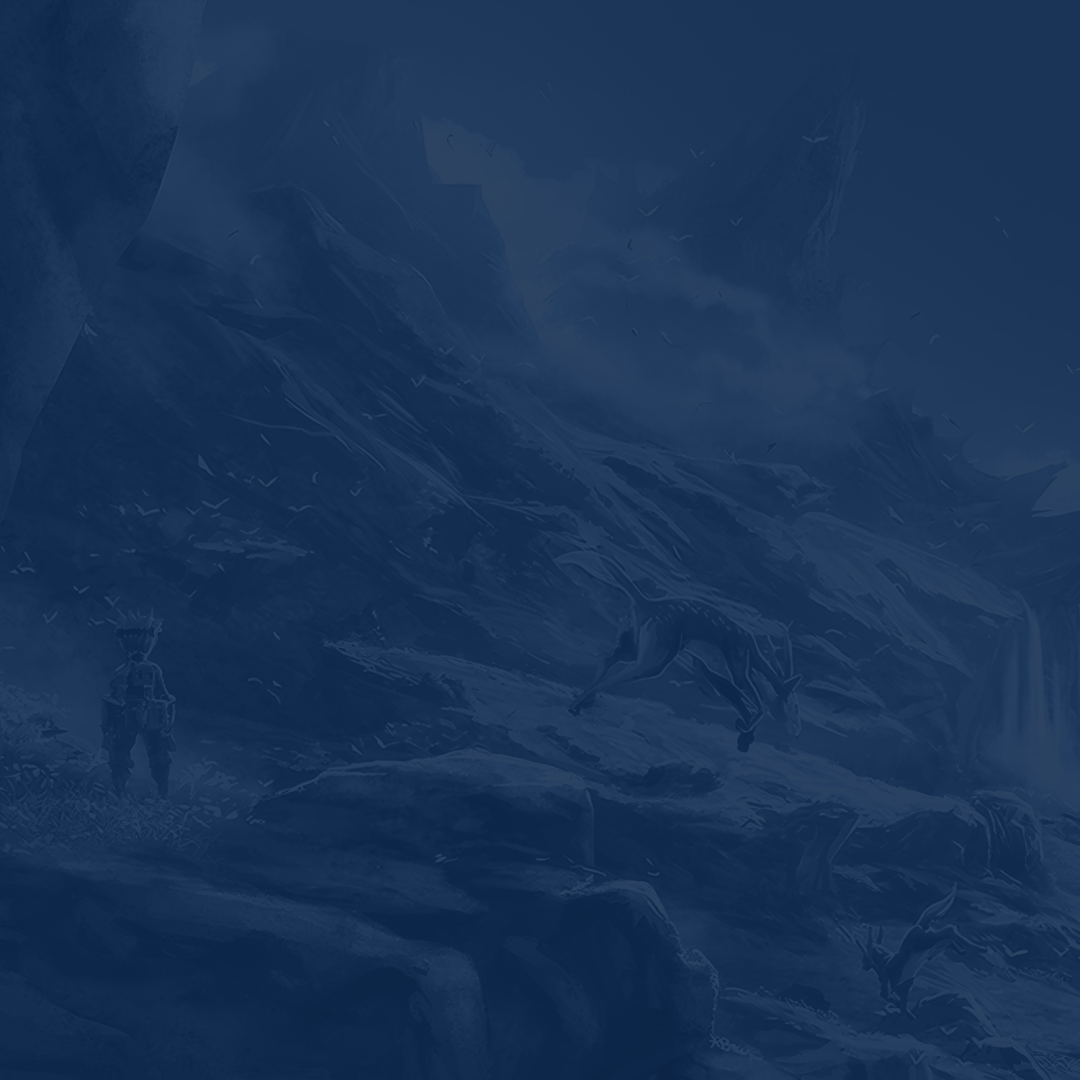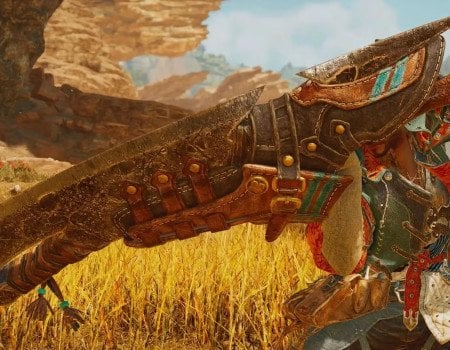Welcome to the Forbidden Lands, Hunters! In this Monster Hunter Wilds beginner guide, you’ll learn the basics of the game so that you can enjoy your first hunts and help fellow Hunters out. We’ll go over things like hunt structure, combat system, armor & weapon crafting, and endgame. If you’re new to this franchise, you’ll encounter a lot of weird systems and mechanics that can be difficult to grasp. Even more or less familiar systems like gathering and crafting consumables are done in a way that may be confusing. If you’re a returning Monster Hunter player who played World, Rise, or any previous installments, this guide will also highlight major changes in Wilds compared to the older games.
Note: At Skycoach, you can Buy Monster Hunter Wilds Boost at the best prices with fast delivery. Use our special PROMO CODE (in green) hidden in this article for a 20% DISCOUNT.
What is Monster Hunter Wilds?
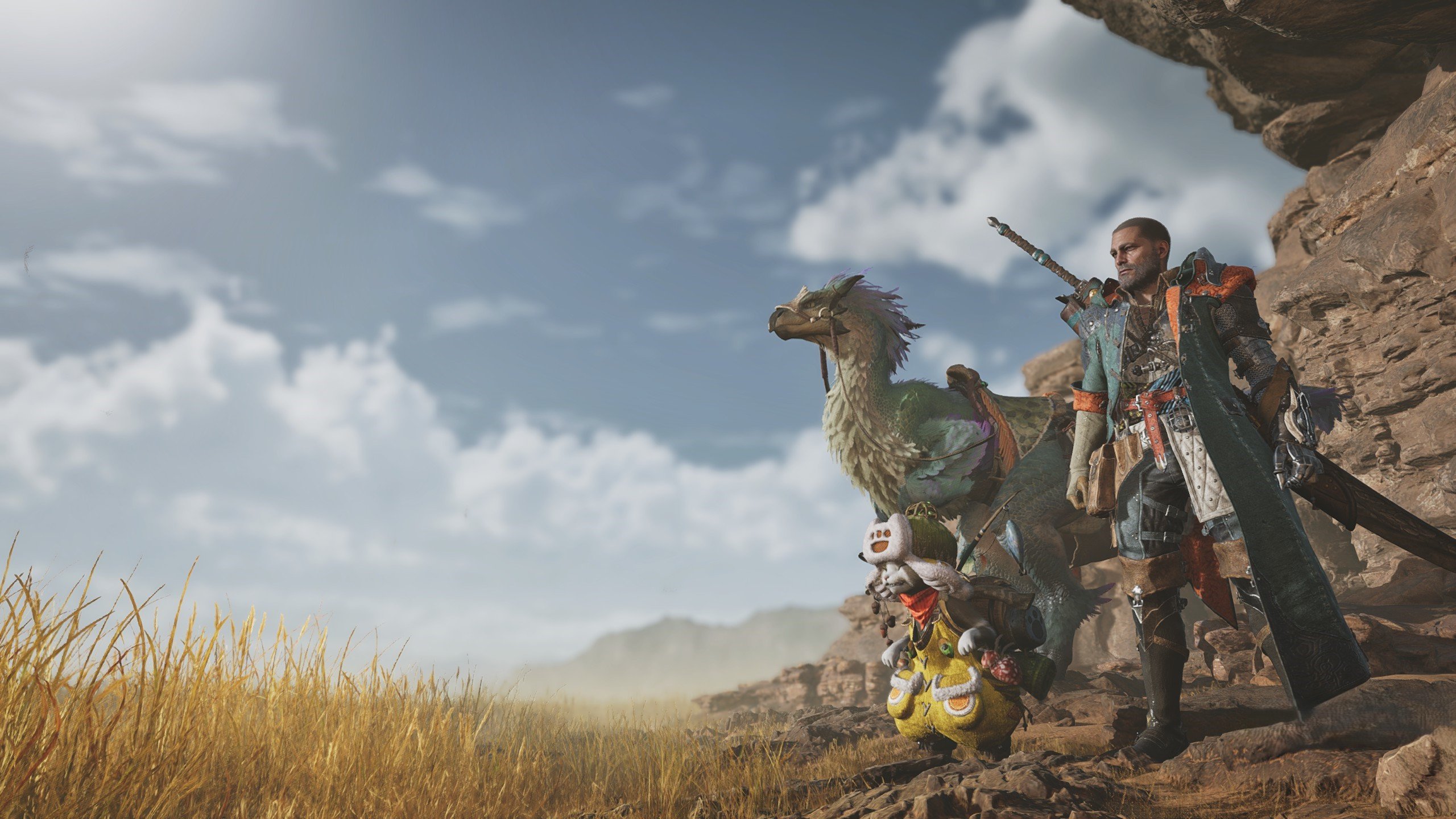
If you’re unfamiliar with the series, let’s just say that this is totally normal. Until 2018 and the release of MH: World, the Monster Hunter series stayed locked in its country of origin - Japan. World was the first game that got ported on PC and had a global launch. Monster Hunter is such a legendary franchise, and it has a huge following and community all over the world. It also created a sub-genre of action games with titles like Dauntless, that are trying to be a monster-hunter-like game, or Dragon’s Dogma, which has a lot of Monster Hunter mechanics.
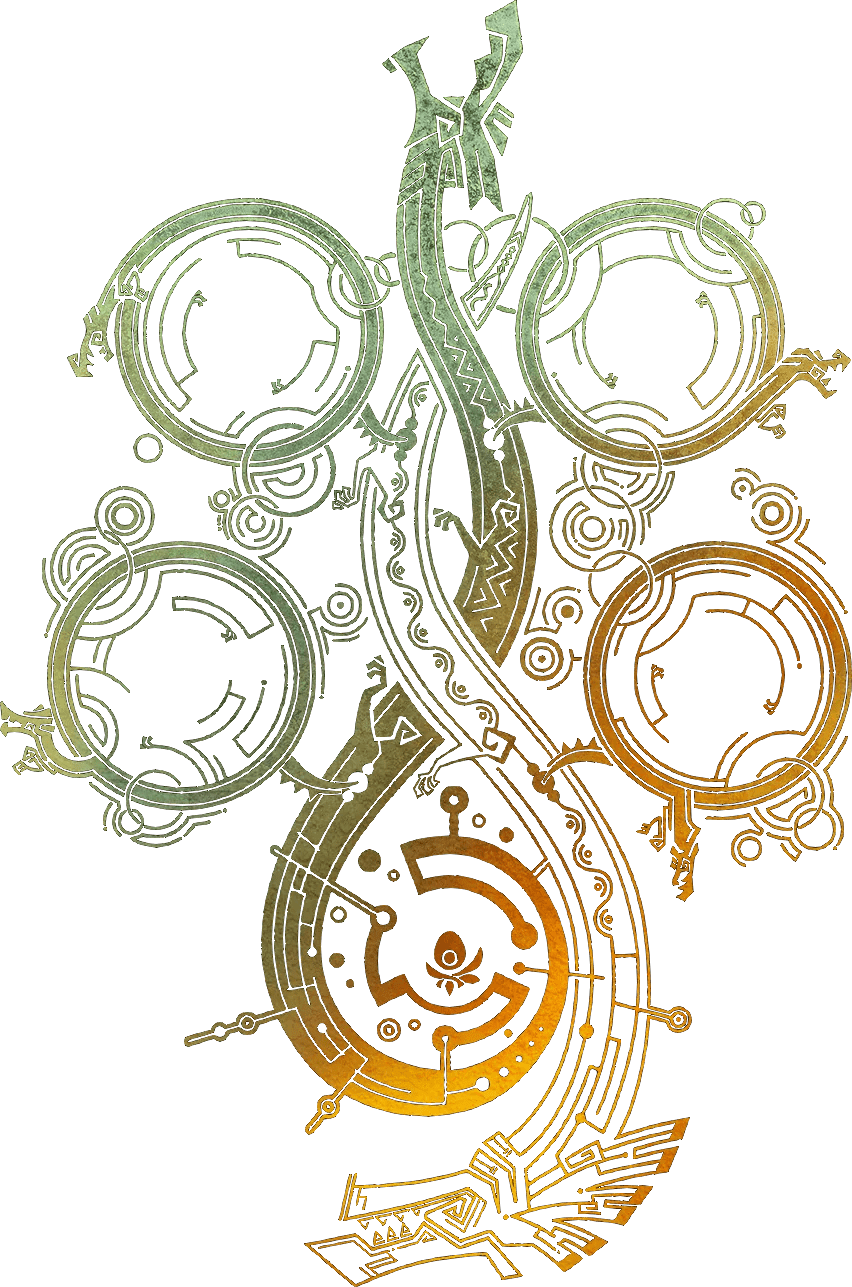
So, what exactly is Monster Hunter? It wouldn’t be a Monster Hunter Wilds complete guide if we didn’t answer this question. In this game, you play as a Hunter from a Hunter’s Guild – an organization created to study and protect nature’s course. Whenever there’s an anomaly or a threat in wildlife, the Guild sends out Hunters to deal with that problem and learn what caused it.
In MH Wilds, your Hunter saves a boy named Nata, who appears to be from a village of people called the Keepers who live in the Forbidden Lands – a territory that was believed to have no wildlife population, let alone human civilization. So, you and your team become the leaders of a new Hunter’s guild expedition to the Forbidden Lands, and your job is to study the uncharted regions and help out locals.
In gameplay terms, the main gameplay loop involves you selecting and accepting a hunt request from the list of available requests or accepting one that’s dynamically appearing when you’re traveling around. Then you prepare for the hunt by equipping the weapon with the type of damage that the target monster is weak to, equipping armor that gives you the skills that will help you withstand that particular monster's attacks, and finally, you craft and equip various consumables that can heal you, provide buffs, remove debuffs, etc.
Next, you leave the camp and track down the monster’s whereabouts by picking up the clues and footprints left by that monster. Eventually, you’ll be able to see where the monster is on the mini-map and where it’s going.
Then, you catch up to the monster and engage in a fight. Once the monster is defeated, you collect unique monster resources from its carcass to make armor or weapons with this monster’s powers. Alternatively, you can capture the monster without killing it, which will give you a different set of rewards and a hefty bonus to the knowledge about this monster. That’s the basics. That’s basically everything you need to know from a Monster Hunter Wilds starting guide. BLOG20
What always makes Monster Hunter games special is how nuanced and deep each of these elements are that make up the gameplay loop. Everything from combat to crafting and gathering has so many little details that you can easily sink hundreds of hours into the game and still learn new stuff you didn’t know about.
Meet The Team
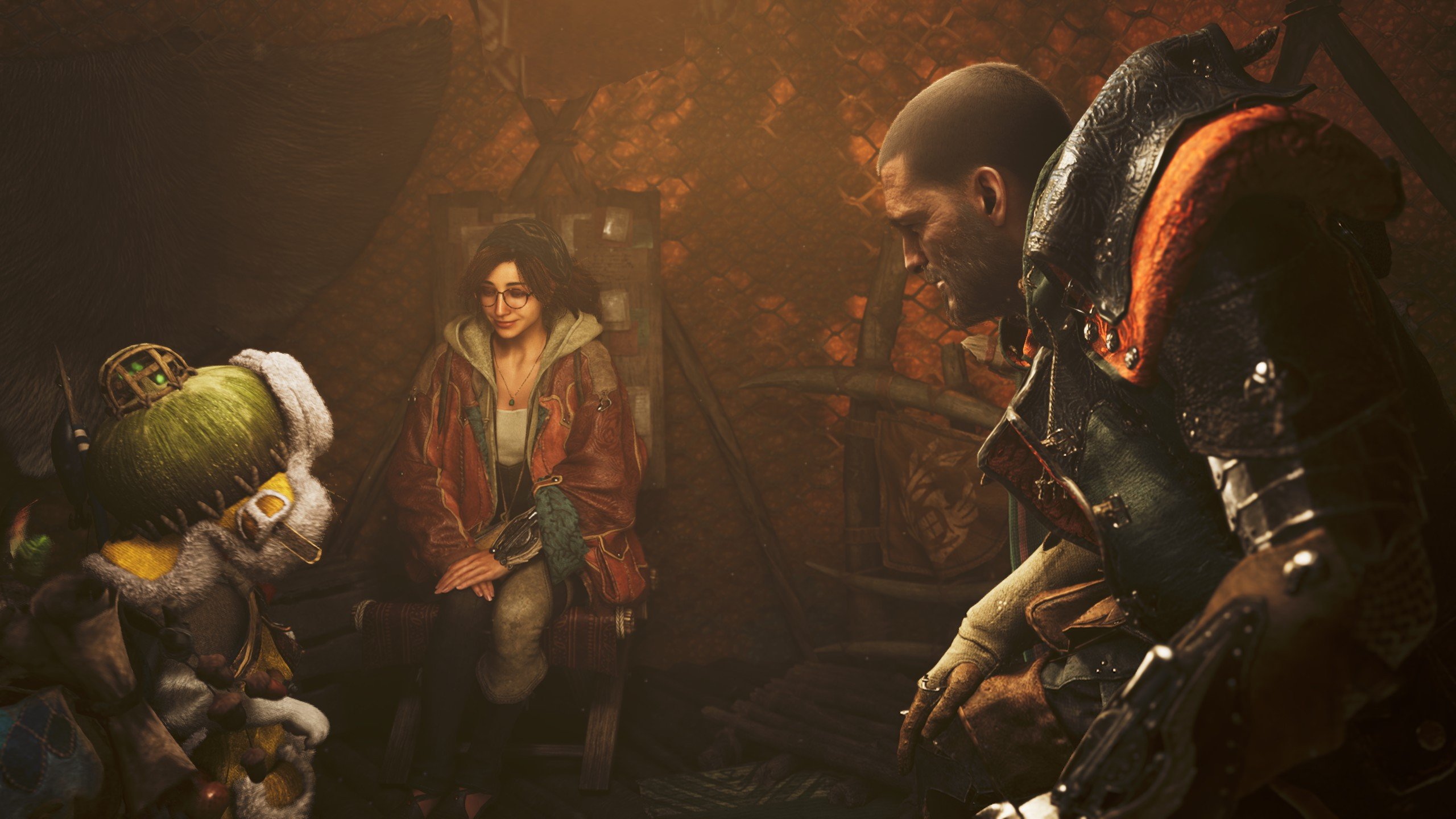
Not every Monster Hunter Wilds gaming guide will explain this, but the main character doesn’t act alone in this game. Each Hunter always has a few other people and creatures helping them. After all, hunting monsters is a team effort. Each Hunter’s Unit consists of:
- The Hunter – that’s you. Your primary job is to track down and defeat monsters. Other tasks include researching the monster, collecting stuff, etc.
- Palico – a feline, cat-like squire that always follows you and helps you in everything you do. You create your Palico along with the main character at the start of the game. Palico comes with its own craftable armor sets and weapons, as well as various combat and non-combat skills.
- Handler – Alma is the Handler to your Hunter. Handlers are the ones responsible for giving out quests or hunt requests. They also document your findings and discoveries. Unlike in the previous game, Alma will also accompany you as you travel around the game's world, but she will stay well out of any fight you get into.
- Blacksmith – someone has to make all of that cool equipment and gear. In your case, Gemma will be your personal smithy. As long as you bring the necessary components, she’ll make you anything from weapons and armor parts to accessories and gadgets.
- Seikret – discovered upon saving that kid that this raptor-bird creature will be your trusty mount and will help you traverse large distances quickly and comfortably. There’s actually a lot that your mount can do. You can even call him to pick you out during battle if you are knocked down!
While you, your Palico, and Alma are out on the hunt, the rest of the team and other characters you’ve met will remain in one of the hubs.
How to Start Monster Hunter Wilds
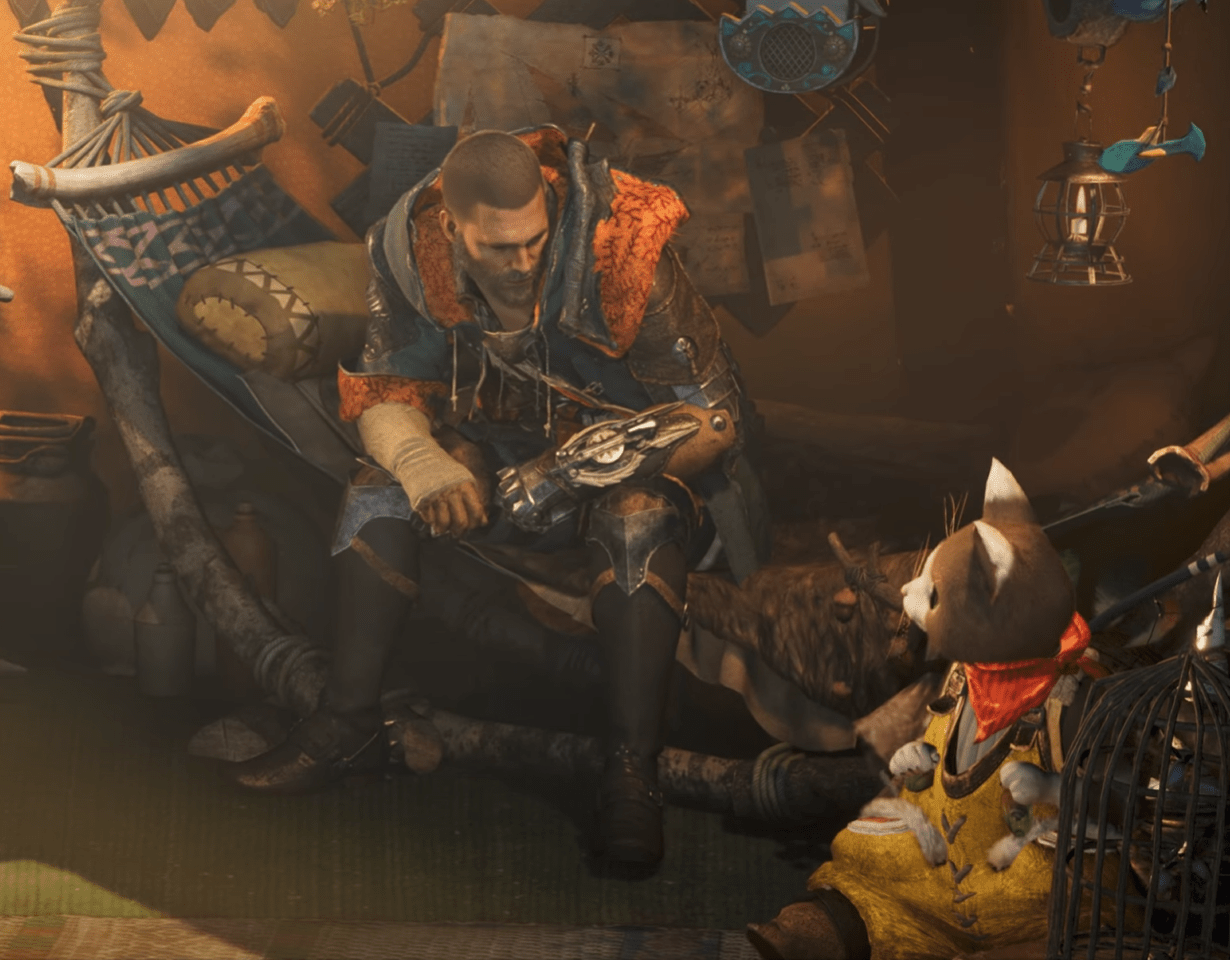
Despite Wilds being an open-world game where you can engage in activities in any order, in the beginning, there’s a handheld portion where you’re introduced to the basics. How to start Monster Hunter Wilds? Just make your Hunter and Palico in the character editor and start playing. You’ll be taken through a few story-driven events and hunts, where you’ll learn the ropes. But, fairly quickly, you’re thrown into an open world where you’ll have a choice between progressing through the story or doing some side-quests and other stuff.
What’s New in Monster Hunter Wilds?
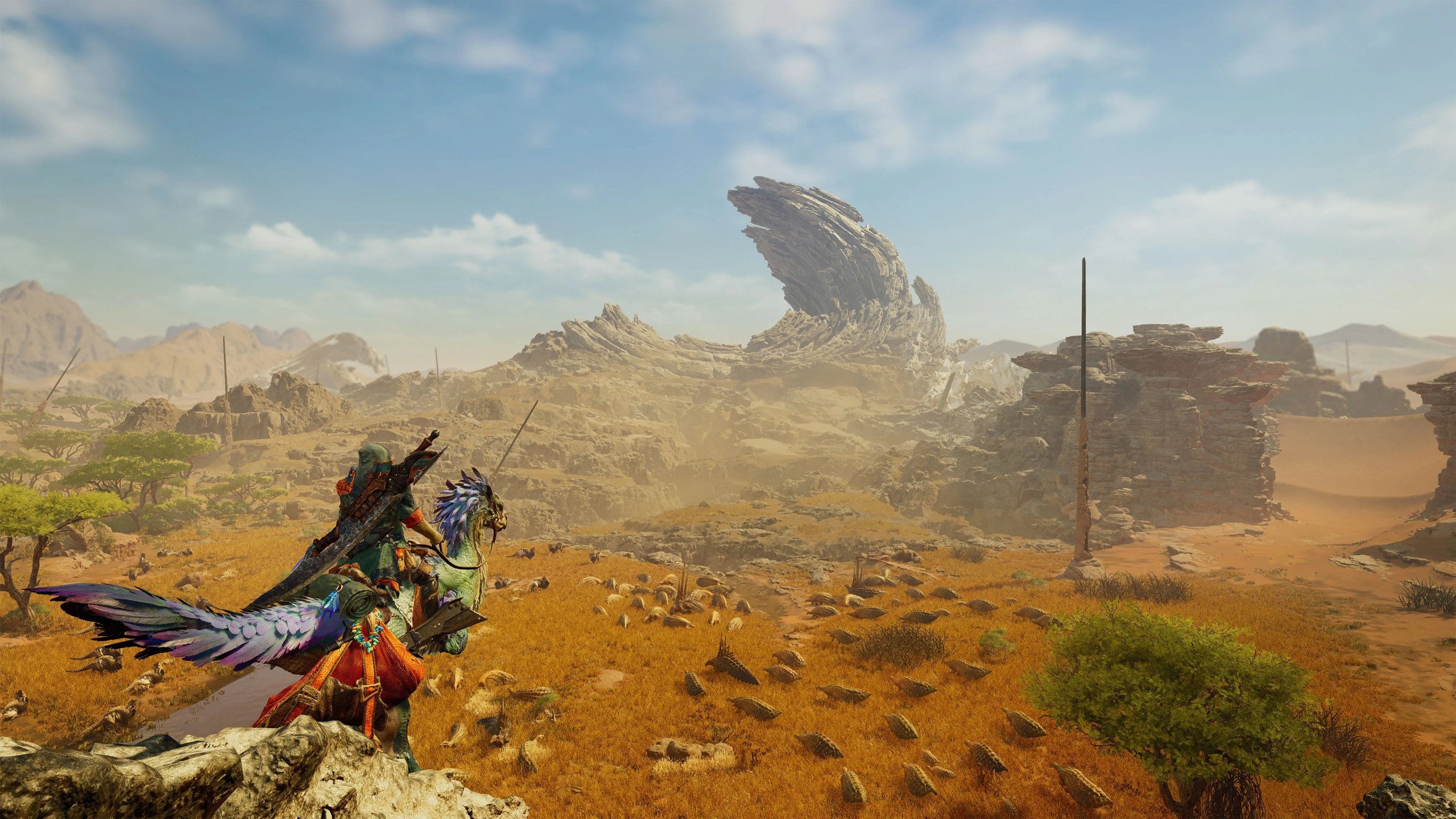
Monster Hunter Wilds for starters, takes a big leap forward, improving on every aspect of the previous Monster Hunter game, which is subtitled World. The biggest change of all is the true-open world. Previously, you had locations like Astera or Seliana where you’d do all of your crafting, accepting quests, trading, etc., and then you would pick any of the hunt locations like Ancient Forest, the Wildspire Waste, where you would load into to find your monsters.
In Monster Hunter Wilds, the safe location, the Hunter’s Guild base (or forward operating base, to be specific), is located within the Windward Plains, the same place where you hunt monsters. So, you go out to the hunt, and the transition is seamless. Each of the three known locations:
- Windward Plains – a region of varied terrain featuring sandy deserts, open grasslands, and unique rock formations. As part of the Research Expedition into the Forbidden Lands, this is the first area you’ll explore. The plains are known for the Sandtide, a massive sandstorm accompanied by thunder that sweeps through the land.
- Scarlet Forest lies beyond the river winding through the Windward Plains, marked by its towering trees and plentiful water sources. A striking feature of this area is the red-hued water pooling on the forest floor, immediately capturing attention as you enter. This region is prone to the Downpour, a relentless rainstorm that floods the landscape and transforms its terrain.
- Oilwell Basin – a unique locale where, as its name suggests, oil wells up from the ground and accumulates in deep pools of oilsilt. This land experiences an Inclemency known as the Firespring, a phenomenon in which fierce fires blaze.
Each of these biomes has its own different weather effects. For example, if there’s a sandstorm in Windward Plains, you’ll see it when you're in your base.
The open-world nature of the game also means that you can now accept hunt requests “on the fly”. There’s no longer a need to return to the camp to review the request board.
Monster Hunter Wilds Combat Basics
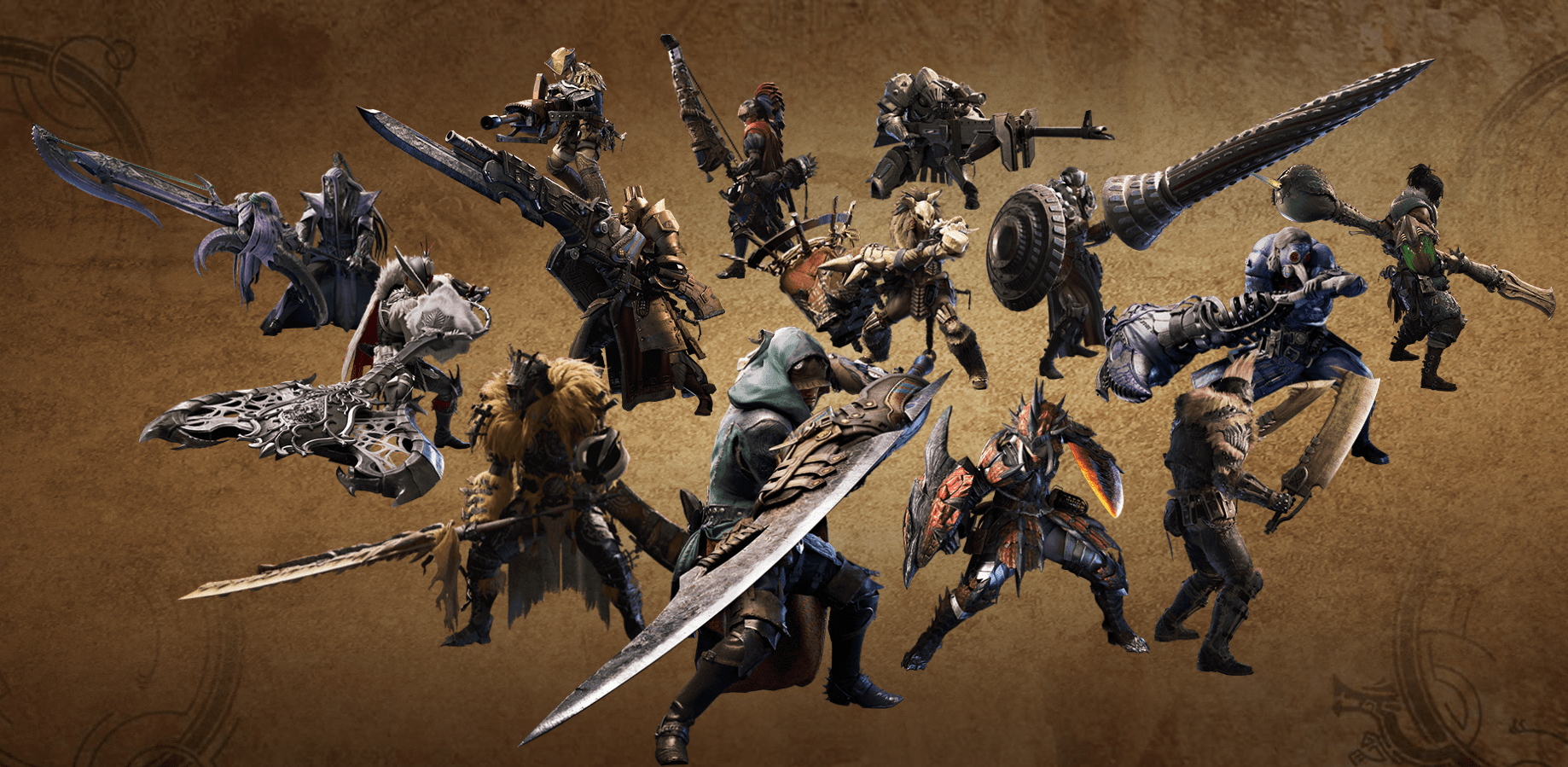
Combat in Monster Hunter Wilds is arguably the most fun thing to do. First of all, all of the 14 weapon types from the previous game are here, albeit with some changes or improvements. In this Monster Hunter Wilds new player guide, we won’t be going into the details of each weapon. The only thing that’s worth saying is that each weapon type is truly different. Not only they have their own move sets, they have completely different gameplay mechanics and fighting styles. Below, you’ll find a short summary of each weapon type as well as what’s changed for them in MH Wilds.
| Weapon Type | Description | What's New in Wilds |
| Great Sword | A weighty weapon with slow attacks, focusing on strong, high-damage hits. Can guard and adapt to various situations. | Introduces Focus Mode for precision aiming during charges. Rising Slash and Focus Attack add new charged mechanics, including potential multiple-wound hits. Rumored mechanics include mounted charge attacks and enhanced True Charge wake-up combos. |
| Long Sword | Excels in swift combos and counters. Has good range. Uses Spirit Gauge levels to power up attacks. | Adds directional control for Spirit Combos and integrates elements from World and Rise. Red Spirit Level and Spirit Charge introduce drastic combo changes. Helm Splitter now has follow-ups, and Focus Attack can rapidly build Spirit Levels. Foresight Slash and infinite Spirit Combos get unique adjustments. |
| Sword & Shield | Balanced weapon with rapid attacks and guard capabilities. Allows item use while drawn. | Restores classic mechanics like Round Slash and Perfect Rush. Introduces shield slam variations with Scaling Slash and an improved Perfect Guard counter. Dismount attacks, multi-phase Focus Attacks, and new slide maneuvers enhance combat flow. |
| Dual Blades | High-speed, dual-wielded weapons with Demon and Archdemon Modes for increased attack power. | Enhances Demon Gauge mechanics with visual effects and new combos. Archdemon Dance and Demon Flurry introduce varied attack paths. Combos can now mix Blade Dance and Demon Flurry, and Focus Attack optimizes positioning. |
| Hammer | A blunt, high-damage weapon effective for stunning monsters. | Adds Mighty Charge for extended charging and powerful follow-ups like Brutal Big Bang. Spinning combos can now flow infinitely, and charging incorporates new mobility mechanics. Focus Attack features a destructive spinning move, offering precision timing with Offset mechanics. |
| Hunting Horn | Blunt weapon with melody buffs for allies and self. | Revives World-like playstyle while keeping Echo Bubbles and self-improvement buffs. Special Performance introduces shockwave attacks requiring song setups. Faster encores, reworked Crush follow-ups, and Focus Attack for rapid precision strikes elevate its utility and offensive potential. |
| Lance | Defensive weapon with strong thrusts and exceptional guard capabilities. | Introduces Power Guard to replace Counter Thrust, eliminating chip damage. Combos like Wide Sweep and Leaping Thrust are enhanced with new animations and mechanics. Perfect Guard triggers shield bash follow-ups, while Focus Attack integrates a powerful thrust capable of hitting multiple wounds. |
| Gunlance | A weapon combining melee and explosive shell attacks with high guarding capabilities. | Shelling mechanics reworked with directional movement and new sweeping attacks like Wyrmstake Full Blast. Reload actions and shell types (Normal, Long, Wide) gain guard points. Focus Attack introduces a drilling Wyrmstake for secondary explosions. Combos prioritize fluidity and explosive power. |
| Switch Axe | A morphing weapon shifting between Axe and Sword modes, combining reach and agility. | Power Axe Mode merges features from World and Rise, enhancing axe attacks and Amp Gauge buildup. Sword Mode introduces Counter Rising Slash combos and Full Release Slash. Amped State mechanics are rebalanced, and Focus Mode offers rapid slashes with varied Elemental Discharge follow-ups. |
| Charge Blade | Morphing weapon combining mobility and power with phial-charged attacks. | Phials are overhauled to reduce usage in Power Axe Mode and integrate new Amped Elemental Discharge follow-ups. Savage Axe Mode becomes Power Axe Mode, offering longer phial-less modes. Focus Attack draws inspiration from Ripper Shield, balancing charged strikes with defensive play. |
| Insect Glaive | A mobile weapon paired with a Kinsect for buffs and aerial combat. | Kinsect mechanics reworked to combine buffs and dust effects seamlessly. Adds Empower Kinsect for triple extract gathering and new abilities like Descending Slash and Rising Spiral Slash. Focus Attack grants buffs without extracts, enhancing aerial mobility and attack variety. |
| Light Bowgun | Mid-range weapon with rapid, ammo-based attacks and high mobility. | Introduces Rapid Fire Mode for burst shooting. Special ammo mechanics and Trick Arrow Gauge optimize efficiency and damage output. Focus Attack adds a replenishable mini-bomb for strategic use. New Chaser Shot and other ammo type reworks enhance versatility. |
| Heavy Bowgun | Long-range weapon with high damage and special ammo for devastating attacks. | Ignition Mode replaces Special Ammo, and new mechanics like Wyverncounter Ignition offer charged attacks. Focus Attack mimics Sticky Ammo while complementing Ignition Mode. Perfect Guard and Rapid Fire-style ammo replenishment boost defense and sustain. |
| Bow | A mid-range weapon balancing mobility, charged attacks, and elemental damage. | Restores World mechanics with quick and power shots. Adds Flying Swallow Shot and Quick Dragon Piercer for dynamic combos. Tracer mechanics enable homing arrows, while Focus Mode introduces a Magick Archer-inspired ability for locking wounds and executing rapid multi-shot attacks. |
Overall, each of the 14 weapons in the game retains its classic combat style. The changes and updates listed above may mean nothing to new players, but they do make moves and attacks more fluid and a little bit faster. More movement during attacks means that these weapons are easier to use and attacks are easier to land, and that adds to the thrill of the hunt. BLOG20
New Combat Mechanics
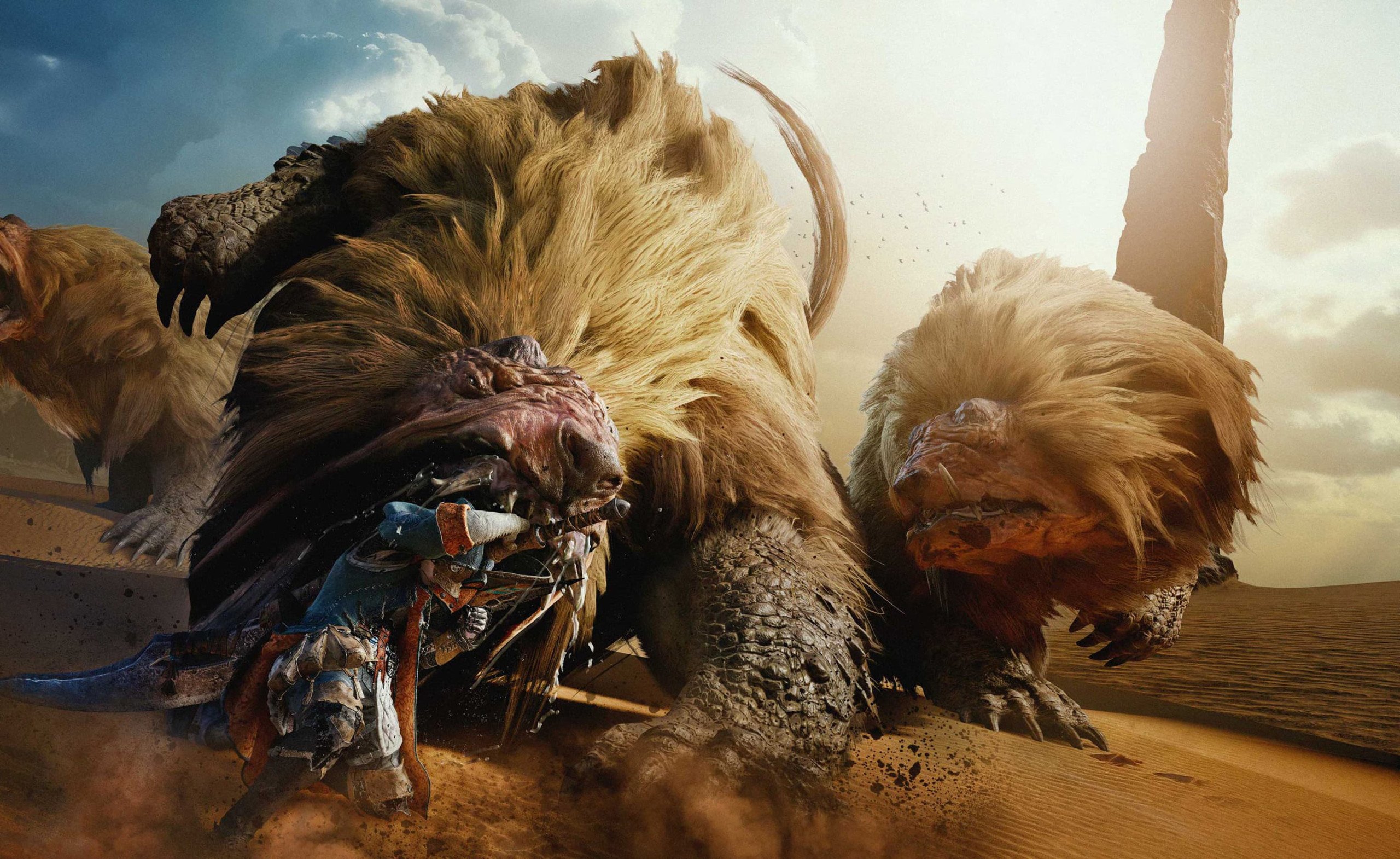
Changes to the weapon’s movements aren’t the only things that got added to Monster Hunter Wild’s combat system, there are some major additions to the combat flow:
- Focus Mode: Enables strafing while slowing down movement compared to normal unsheathed walking. It allows precise attack aiming and visibility of monster wounds. Holding the button for running activates Focus Mode, which grants access to the Focus Attack. Focus Mode encourages strategic planning, with notable changes like the Insect Glaive’s mechanics.
- Focus Attacks: These activate a full attack animation only when striking a wounded area. Focus Attacks deliver a burst of damage upon contact, and wounds hit by such attacks may vanish. Attacking areas with multiple wounds may amplify damage output.
- Simplified Attack Values: Weapon attack values displayed in menus are not inflated, ensuring clarity and straightforward comparison.
- Integrated Weapon Skills: Weapons now come equipped with pre-integrated skills, enhancing gameplay versatility.
- Mounting Changes: Players can use both knives and weapons for mounting attacks. Knife-based mounting mimics the mechanics from Monster Hunter World, offering speed and precision. Weapon-based mounting is slower but allows follow-up attacks to topple monsters. Mounted finishing attacks function similarly to Focus Attacks, requiring targeting of wounds.
- Offset Attacks: Certain weapons include Offset Attacks, capable of toppling monsters when timed correctly to counterattack or parry. These attacks may trigger additional follow-ups. For instance, the Great Sword features an Offset Attack that activates Divine Blessing when timed correctly, even if the player takes damage.
- Perfect Guard Mechanics: Weapons with guard capabilities can perform a Perfect Guard. This mechanic operates similarly to Insta-Block or Adept Guard from MHGU. It may not always include direct follow-ups, but it effectively mitigates damage when blocking attacks. Details regarding stamina and health effects are not fully clear.
- Movement and Attack Adjustments: Standard attack movements retain a familiar flow unless a significant change is noted in the control guide. Dramatic movement alterations are left for player observation unless explicitly documented.
The new wound mechanic in Monster Hunter Wilds introduces a more strategic element to combat by focusing on creating and exploiting vulnerable spots on monsters. Wounds appear after specific attacks or sustained damage to certain body parts and are visually distinct (glowing red), making them easy to spot during battles.
These wounds serve as key targets for Focus Mode and Focus Attacks. Focus Mode lets you aim precisely at wounds, and landing a Focus Attack on one triggers a powerful burst of damage with a special animation. Once hit, wounds may disappear, requiring you to create new ones. Additionally, wounds can heal over time if left alone, encouraging players to act quickly.
Each weapon interacts with wounds in its own way. For instance:
- The Bow can use Tracer mechanics to make arrows home in on wounds.
- The Great Sword delivers devastating True Charge attacks to wounded areas. This system rewards precision and highlights each weapon's strengths, encouraging tactical play.
So, if you’re wondering how to start playing Monster Hunter Wilds as a beginner, learn to use the wounds mechanic. More experienced hunters who played previous games will notice that and will respect you for it! Besides, you can coordinate to attack different wounds, maximizing the party's overall effectiveness. The wound mechanic adds depth to combat by shifting the focus from just dealing with damage to strategically targeting and exploiting weak points. This makes battles more engaging and rewarding for players who adapt to this new layer of strategy.
Armor and Weapon Crafting
The signature feature of any Monster Hunter game is using monster parts to make stylized weapons and armor. This is where this game shows its depth because armor and weapons have systems within systems. You’d almost never see people google something like how to play Monster Hunter Wilds. Instead, you see a lot of searches for how crafting works. So, let’s break down the basics.
Crafting Armor Sets
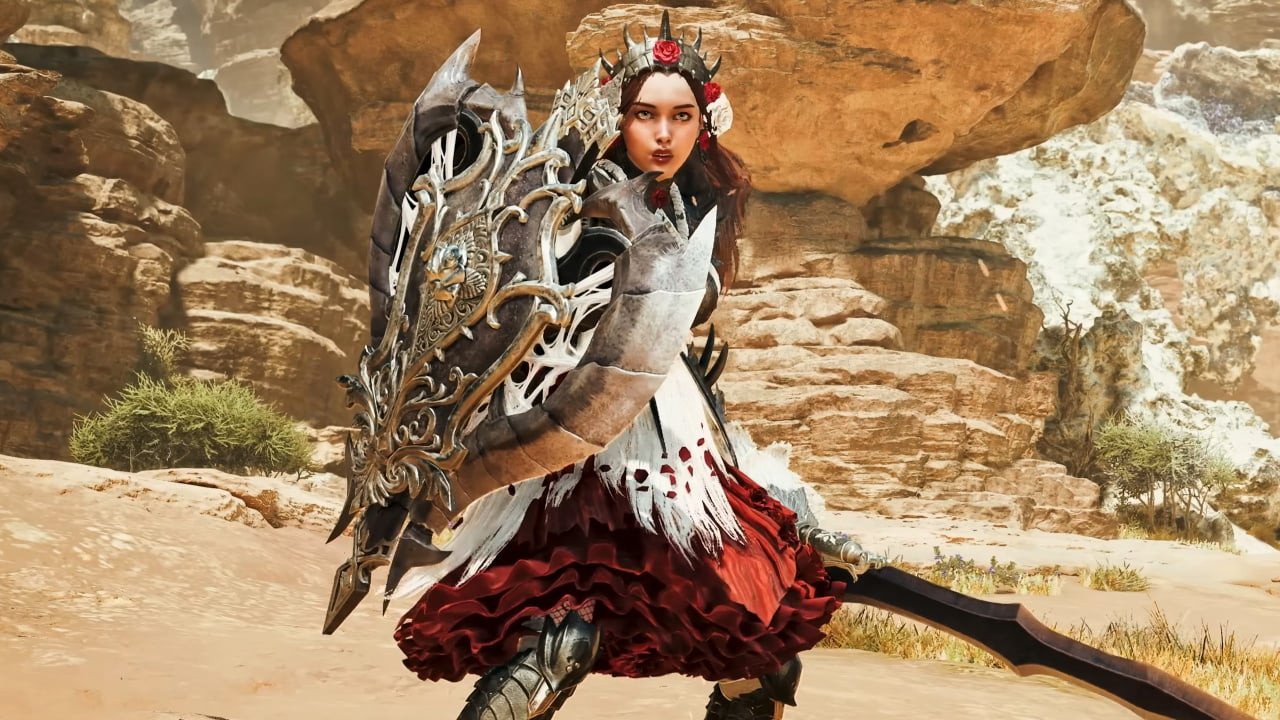
One of the most important parts of making a build for your hunter is deciding on the armor. MH fans always argue about what’s better – using armor pieces from the same set or using parts from different sets. Here’s how it works.
There are five armor pieces that make a set:
- Helmet
- Chest
- Hands
- Legs
- Boots
Each piece comes with its own properties:
- Level – can be increased through a system to increase the armor stats. BLOG20
- Rarity – represents a tier. A higher tier requires more resources to craft and is generally better. Also has higher stats.
- Defense – represents general defense value.
- Slots – the amount and the grade of slots for charms. Tells you what level of gems you can insert and how many.
Vs. Fire, Water, Thunder, Ice, Dragon – shows defense against a certain type of damage. If the value is negative, it means that your default defense against that type of damage is reduced. In other words, certain armor pieces make you weaker against certain types of damage but stronger against other types! - Skills – passive effects and bonuses that you get from having a piece of armor equipped. Equipping more armor pieces with the same skill stacks its effects, making these skills stronger.
If you hover over an entire armor set, you can see the list of pieces that make the set, the total defense stats, and all skills provided by all armor pieces from that set. So, in a sense, by combining armor pieces from different sets, you can make a very specific build. On the other hand, using full sets allows you to insert more potent gems. More on that later.
All armor is divided into ranks based on the type of monsters that you kill.
- Low Rank – obtained from low-rank hunt requests.
- High Rank – obtained from high-rank hunt requests in mid-game.
- Master Rank – obtained from endgame hunt requests and quests.
Despite the fact that there are the same sets in each of the ranks, these sets have visual differences, and their stats vary slightly.
To make a piece of armor, you need to come to your Smithy Gemma, select the armor piece, spend the required materials (which sometimes include special Tickets), and pay Zenny (this game’s equivalent of gold).
Crafting Weapons
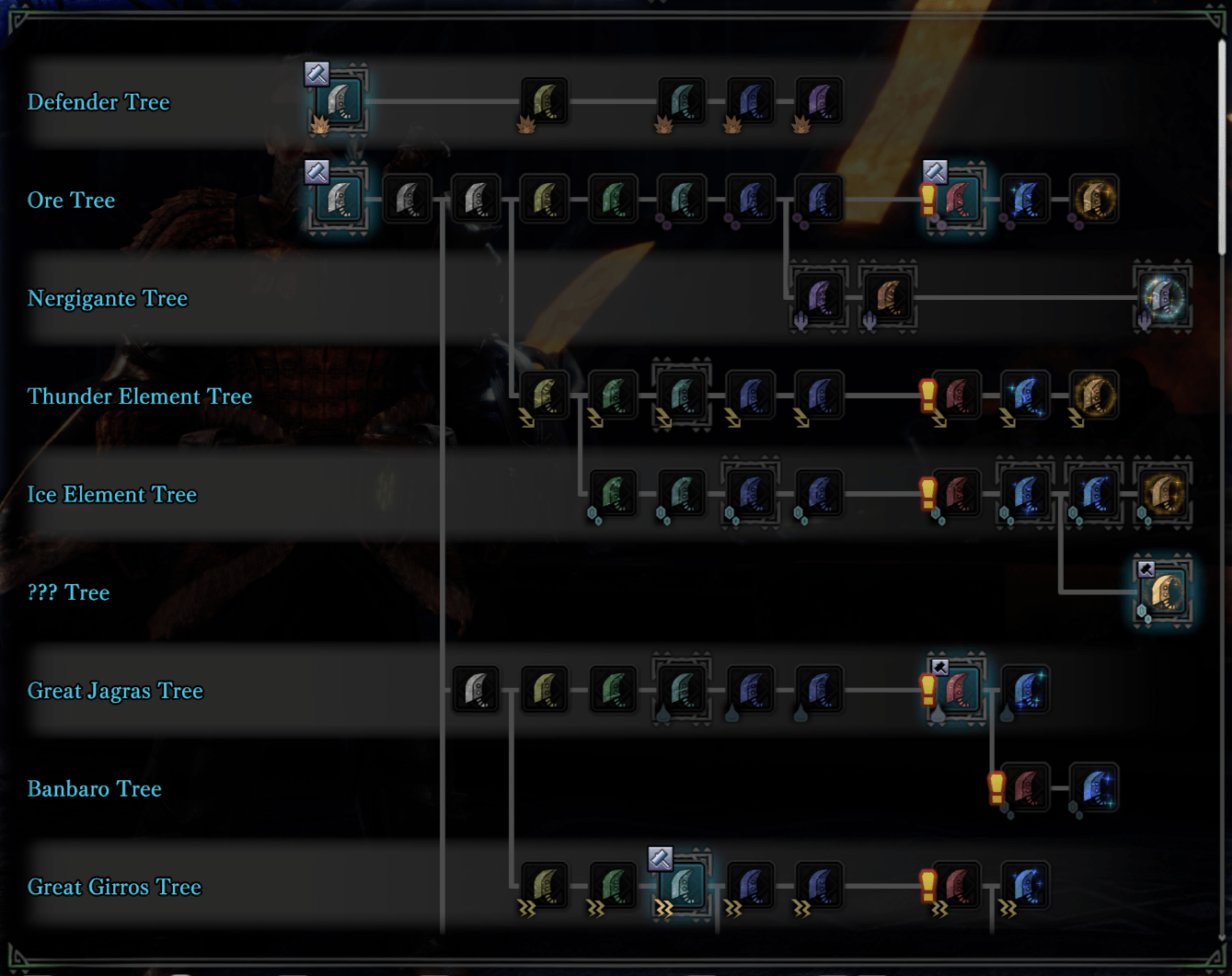
Making weapons in Monster Hunter Wilds is the second most important decision you’ll make because a specialized weapon is essential to hunt your next target more effectively.
If you’re new to the game, the 14 weapon types are simply categories. Each weapon type has its own crafting tree, which determines the progression and customization of that weapon. Here’s how it works:
- Forging: This creates the first entry of a weapon tree. It's the starting point for any new weapon.
- Upgrading: Once forged, a weapon can be upgraded. Upgrading improves its stats, such as attack power, elemental properties, sharpness, or affinity. Many trees also feature branching paths, allowing you to create alternate versions if you have the materials and the base weapon.
Key Mechanics of Weapon Crafting and Upgrading:
- Materials and Zenny: Crafting and upgrades require specific monster materials or resources gathered in the wild, along with Zenny, the in-game currency. As you encounter stronger monsters, you'll unlock access to rare materials that open up advanced parts of the weapon tree.
- Branches and Customization: Upgrading a weapon often presents you with branching paths. For example, you might choose between higher raw damage or adding elemental properties like fire or ice. These branches allow you to customize your weapon for different monsters' weaknesses.
- Sharpness: A crucial stat for melee weapons, sharpness tiers (e.g., green, blue, white) improve damage and prevent your attacks from bouncing off tougher monster parts. Certain weapon paths focus on achieving higher sharpness levels, which can be critical for endgame hunts.
Once you progress far enough, you'll unlock the augmentation system. Augmentations allow you to further enhance your weapons by adding attack power, improving affinity (critical hit chance), boosting defense, or even adding lifesteal effects. This system is key for tailoring high-tier weapons to your personal playstyle.
Monster Hunter Wilds Tips and Tricks
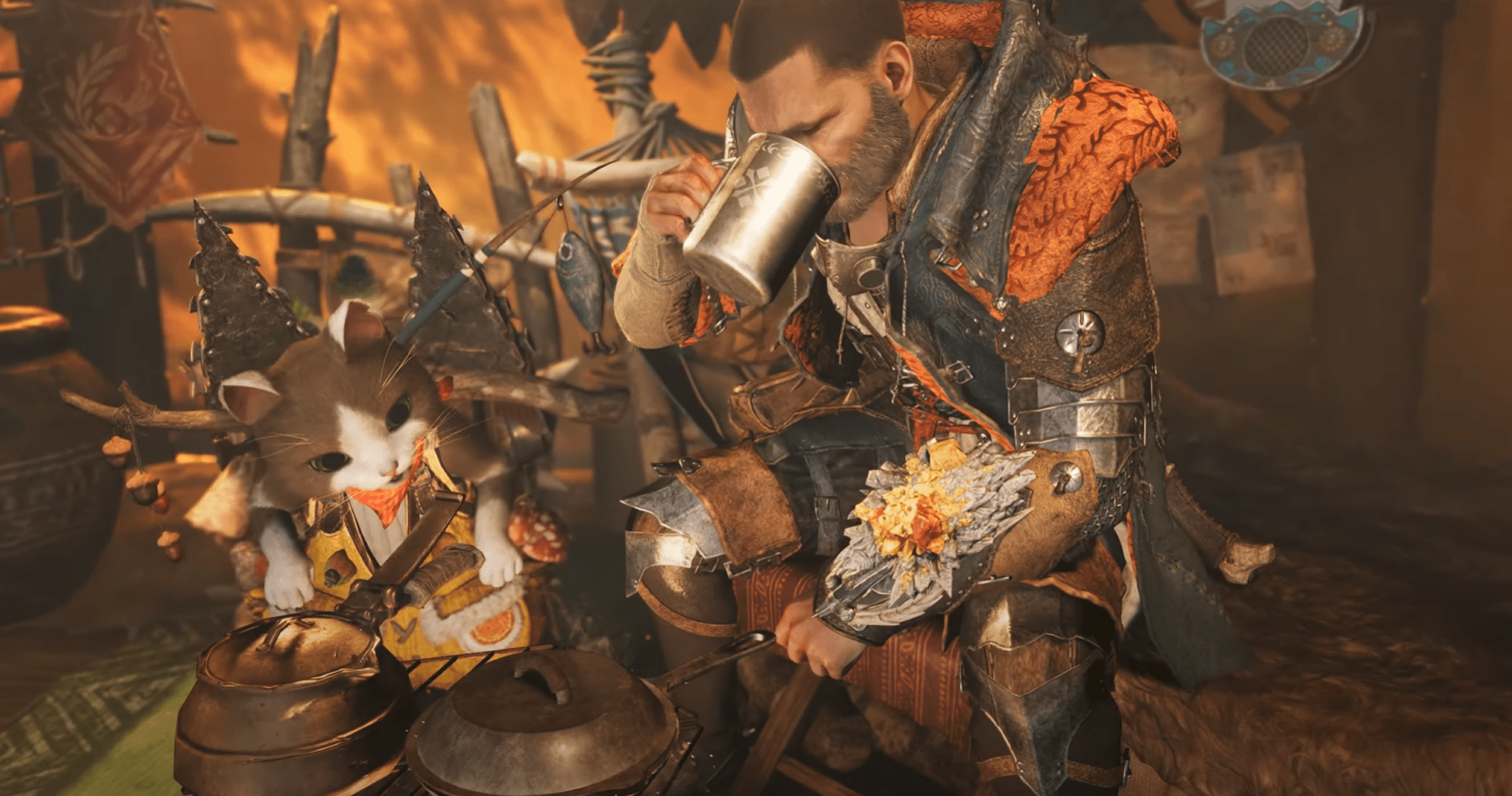
With so many new elements added to MH Wilds, a lot of really useful functions will easily fly over new players’ heads. Here’s a list of Monster Hunter Wilds tips that you should try out that will make your life a lot easier in this game:
- Use SOS flare – if you want to make your game 80% easier, just call in random players to join you on your hunt. The process is very seamless – at any point during your hunt, you can use the SOS flare, and up to 3 random players will join you. If you’re playing offline, you can use this to summon AI-controlled hunters. You might not learn the game that way, but it’ll be much easier and more fun to play like this.
- Always cook meals – cooking and consuming meals to increase your maximum health and maximum stamina and add skills to your Palico and your Hunter is a must. Remember that you can now cook in your little camps that you can set up outside of the main base.
- Use quick-slot items – there are two UI elements that allow you to quickly use one of your items in your pouch – the radial menu and the item bar. The radial menu can be compared to the Favorites menu from Skyrim. If you’re using the gamepad, it’s super easy to use one of the 8 items there. The item bar is like your quick bar in MMORPGs; you can only see one selected item from that bar, and you have to scroll to select another before using it. Both of them can be customized. Make sure you always have traps, Tranq bombs, potions, and cooked steaks in either of them.
- Use Seikret to heal up safely mid-combat. Your mount is much too fast for most monsters, so you can call it, and it will quickly pick you up so you can run circles around the monster, healing and buffing.
- Learn monster weaknesses – your Hunter’s Notes is where you will find detailed descriptions of the monsters you found and defeated. To make your hunts much easier and faster, make sure you know which type of damage the monster is weak to and bring the weapons that deal that type of damage.
Actually, as someone whose first Monster Hunter game was World, I can say that the best Monster Hunter Wilds tips for beginners was to take it slow and not rush the progress. When you take your time to enjoy the game, you learn much more that way, instead of chasing down meta builds and whatnot. These tips should be enough for new players to get started. As you play the game, you’ll learn more neat things and ways to improve your effectiveness as a hunter.
Conclusion
Monster Hunter Wilds is a massive game that’s done a lot to appeal to the Western community and new players by streamlining a lot of its core mechanics. It may not click with you right away, but if you give its combat system time, it’ll start making sense, and when it does, you’ll be hooked! Fans are sinking in thousands of hours and are not getting bored, even though there are no season passes, and it’s not a looter shooter.
With this guide by your side, you can enjoy the game, and everything it has to offer, and I can almost guarantee that it’ll capture your soul and drink up your time for a good while.
F.A.Q.
What is the best Monster Hunter game to start off with?
You should start with the latest installment – Monster Hunter Wilds. You don’t have to play any of the previous games to understand what’s going on or how to play. Traditionally, the story takes a backseat in favor of gameplay, so you can start with the latest entry.
How to start with Monster Hunter Wilds?
Just create your character and start following the story. The first couple of hunts will serve as a tutorial where you’ll learn the basics and pick your first weapon type.
How can I play Monster Hunter Wilds?
Just install the game, create your Hunter, and start playing. You can either join an online session, which will allow you to call other hunters for help, or play solo.
Can you play Monster Hunter Wilds solo?
Absolutely! You and your trusty Palico are all that you need to defeat any monster! It could be a bit more difficult for new players without other players' help, but if you’re a returning Monster Hunter, you will manage solo hunts just fine.
How do you craft new weapons in Monster Hunter Wilds?
To craft anything in this game, you’ll need materials, which, depending on the item you want to craft, either drop from defeated monsters or gather from special resource nodes like ore, plants, etc.



